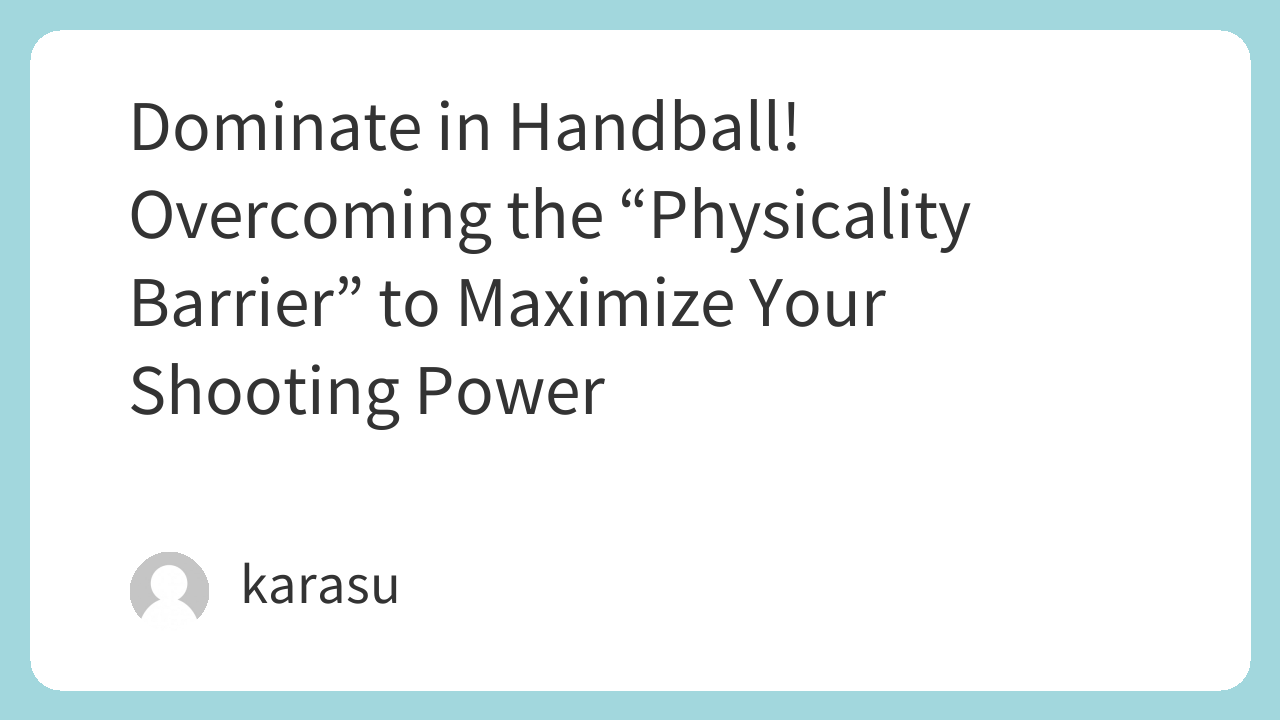Do you feel that your “physicality is lacking” or that you “get outmuscled in contact plays” in handball? It’s frustrating when you can’t use your body effectively, especially when shooting or defending, isn’t it? But don’t worry. By approaching your physical development correctly, your game can transform.
This blog post will thoroughly explain concrete methods to build a “strong, usable body” for handball. We’ll focus not just on gaining weight, but on how to effectively translate that into your gameplay.
Why is “Physicality” Important in Handball?
In handball, speed and skill are crucial, but physical strength is also incredibly vital. A strong physique provides advantages in the following situations:
- Dominance in Contact Plays:
- On offense, you’ll be less likely to get outmuscled by defenders, making it easier to create shooting space.
- On defense, a strong physique becomes a powerful weapon for stopping opponent breakthroughs and winning the ball.
- Stability and Power Transfer During Shots:
- A strong core and stable lower body allow you to generate power with your entire body during a shot and transfer it efficiently to the ball.
- Improved balance in the air leads to more accurate and powerful jump shots.
- Jump Shot Height and Defensive Blocking Ability:
- Being able to shoot from a higher position gives you more options to shoot over defenders.
- During blocks, you’ll be able to more effectively obstruct the opponent’s shooting lane.
- Maintaining Stamina Throughout the Match:
- A strong body is more resilient to fatigue, which is essential for maintaining high performance until the end of the game.
Approach to Building a “Strong, Usable Body”
What handball demands isn’t just a heavy body. It’s crucial to build a “functional body” that possesses strength and agility.
1. Diet and Nutrition Strategy: Laying the Foundation for Body Building
No matter how much you train, your body won’t develop sufficiently without proper nutrition. To increase muscle mass and improve performance, a diet rich in the following nutrients is essential:
- Protein: The building blocks of muscle. Actively consume meat, fish, eggs, dairy products, and soy products with every meal. Aim for 1.5g to 2g per kg of body weight.
- Carbohydrates: The primary energy source for exercise. Consume a balanced intake of rice, bread, noodles, and potatoes, and pay particular attention to energy replenishment before and after workouts.
- Fats: Important for hormone production and as an energy source, but consume in moderation. Choose healthy fats from sources like nuts, avocados, and olive oil.
- Vitamins and Minerals: Crucial for muscle synthesis, fatigue recovery, and overall bodily function. Consume a rich variety of vegetables and fruits daily.
Smart Use of Nutritional Supplements
- Protein Powder: Useful when it’s difficult to get enough protein from food alone. Consuming it within 30 minutes after training (the “golden hour”) can efficiently promote muscle recovery and growth.
- Snacks: If your three main meals don’t provide enough calories, incorporate nutritious and easily consumable snacks like rice balls, bananas, yogurt, or nuts.
2. Thorough Core Training: The “Key” to Transferring Full Body Power to the Ball
The core, located at the center of your body, plays an extremely vital role in connecting the forces of your upper and lower body and transferring overall power to the ball. A stable core prevents your axis from wobbling during shots, allowing you to exert force more efficiently.
Specific Core Training Exercises
- Plank: A fundamental core exercise. Maintain a straight line with your body, focusing on engaging your abs and back muscles.
- Side Plank: Strengthens the obliques (side abdominal muscles) and improves lateral body stability.
- Russian Twists: Sitting with your feet off the ground, twist your torso to train core rotation. Particularly effective for enhancing the twisting motion during a shot.
- Bird-Dog: On all fours, simultaneously raise opposite arm and leg. Develops core stability and balance.
- Dead Bug: Lying on your back, slowly lower opposite arm and leg simultaneously. Trains the ability to control limb movements while maintaining core stability.
3. Overall Muscle Balance and Endurance
In handball, it’s crucial to build overall muscle strength in a balanced way, not just specific muscles. Additionally, endurance is essential for maintaining performance throughout the match.
- Full-Body Strength Training: The aforementioned weight training (squats, deadlifts, etc.) is highly effective for simultaneously training large muscle groups like the lower body, core, and back, improving overall body coordination.
- Emphasis on Compound Movements: Incorporating compound movements that involve multiple joints and muscles, such as squats to jumps, or lunges while throwing a medicine ball, can develop more functional strength that translates to the game.
- Endurance Training: Incorporate interval training, long-distance running, or circuit training to build the cardiovascular and muscular endurance needed to keep moving until the end of the match.
Conclusion: Planned Physical Development Transforms Your Play
Building a body that won’t be outmuscled and that enhances your shooting power in handball requires planned and consistent effort. By combining diet, strength training, core strengthening, and endurance training in a balanced way, your body will surely change, and the quality of your play will significantly improve.
Don’t rush, but work steadily towards your goals. Your efforts will lead to confidence and results in your matches.
In the next article, we’ll delve into “Strategies to Overcome Lack of Match Experience” to help you improve your practical skills even with limited game time. Stay tuned!



コメント